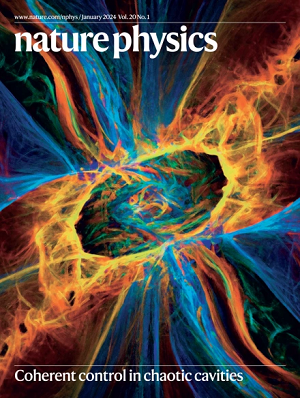Strings and topological defects govern ordering kinetics in endothelial cell layers
IF 18.4
1区 物理与天体物理
Q1 PHYSICS, MULTIDISCIPLINARY
引用次数: 0
Abstract
Many physiological processes, such as the shear flow alignment of endothelial cells in the vasculature, depend on the transition of cell layers between disordered and ordered phases. Here we demonstrate that such a transition is driven by the non-monotonic evolution of nematic topological defects in a layer of endothelial cells and the emergence of string excitations that bind the defects together. This suggests the existence of an intermediate phase of ordering kinetics in biological matter. We use time-resolved large-scale imaging and physical modelling to analyse the non-monotonic decrease in the number of defect pairs. The interaction of the intrinsic cell layer activity and the alignment field determines the occurrence of defect domains, which defines the nature of the transition. Defect pair annihilation is mediated by string excitations spanning multicellular scales within the cell layer. Our results, therefore, suggest a mechanism by which intermediate ordering and string excitation might contribute to regulating morphogenetic movements and tissue remodelling in vivo. Imposing shear flow on a cell layer induces an ordering transition. Now it is shown that an intermediate phase of ordering occurs driven by an interplay between cellular activity and the aligning field.

弦和拓扑缺陷控制内皮细胞层的有序动力学
许多生理过程,如血管中内皮细胞的剪切流排列,依赖于细胞层在无序和有序阶段之间的过渡。在这里,我们证明了这种转变是由内皮细胞层中向列拓扑缺陷的非单调演化和将缺陷结合在一起的弦激励的出现驱动的。这表明在生物物质中存在有序动力学的中间阶段。我们使用时间分辨的大尺度成像和物理模型来分析缺陷对数量的非单调减少。固有细胞层活动和对齐场的相互作用决定了缺陷域的发生,缺陷域定义了转换的性质。缺陷对湮灭是由细胞层内跨越多细胞尺度的弦激发介导的。因此,我们的研究结果表明,中间排序和弦激发可能有助于调节体内形态发生运动和组织重塑的机制。在细胞层上施加剪切流会引起有序转变。现在表明,排序的中间阶段是由细胞活动和对齐场之间的相互作用驱动的。
本文章由计算机程序翻译,如有差异,请以英文原文为准。
求助全文
约1分钟内获得全文
求助全文
来源期刊

Nature Physics
物理-物理:综合
CiteScore
30.40
自引率
2.00%
发文量
349
审稿时长
4-8 weeks
期刊介绍:
Nature Physics is dedicated to publishing top-tier original research in physics with a fair and rigorous review process. It provides high visibility and access to a broad readership, maintaining high standards in copy editing and production, ensuring rapid publication, and maintaining independence from academic societies and other vested interests.
The journal presents two main research paper formats: Letters and Articles. Alongside primary research, Nature Physics serves as a central source for valuable information within the physics community through Review Articles, News & Views, Research Highlights covering crucial developments across the physics literature, Commentaries, Book Reviews, and Correspondence.
 求助内容:
求助内容: 应助结果提醒方式:
应助结果提醒方式:


